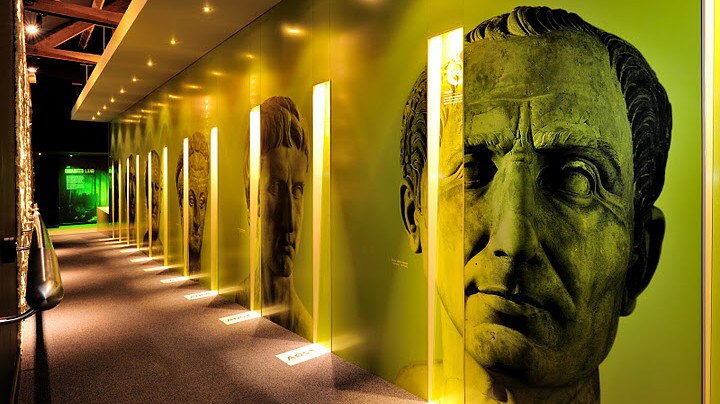The Vindolanda Trust’s two tourist attractions ‘The Roman Army Museum’ and ‘The Roman Vindolanda Fort and Museum’, deployed audio-visual technology to dramatically demonstrate Roman life on the edge of the empire 2000 years ago. Under the contract of Edinburgh based exhibition designer Studio MB, Electrosonic was the AV Systems Integrator for the exhibition displays.
Related: Electrosonic Profile / Electrosonic wins Award for ‘Business Installation of the Year’ for iZone at Deloitte / Sound Advice from Leading Lights: The Future for Audiovisual in the Attractions Business
The two museums make excellent use of the Trust’s archaeological discoveries near Hadrian’s Wall to bring Roman times to life. Audio-visual techniques are used sparingly, but to great effect, showing archaeologists live at work uncovering Roman artefacts, immersing visitors in the life of a Roman solider and re-telling the story of daily life in Roman times.
The re-development of the project was an initiative of the Vindolanda Trust. Fiona Watson, Vindolanda’s Finance and Information Officer, who was greatly involved with the project, said “We are very impressed with the quality and standard of the work throughout. Electrosonic worked effectively and efficiently as part of the Studio MB team and we are happy with the service they provided and the work they completed.”

The ‘Recruitment Exhibit’, housed in the same gallery, uses a large Pepper’s Ghost display to effectively bring to life the harsh reality of being in the Roman army. A rather terrifying ‘Recruiting Centurion’ comes to life, standing in his field tent, sizing you up to see if you are fit for service. This exhibit posed the biggest challenge of the project. To ensure the Pepper’s Ghost display interacts with the physical setwork, the product, AV hardware and setwork all have to be carefully co-ordinated and aligned. Various factors made achieving this a challenge; firstly the space is very confined, and secondly the changing air pressure in the space, and the buildings vibrations made it impossible to use a stretched foil semi silvered mirror in this application, instead a glass semi silvered mirror was used to achieve image stability.
The ‘Wall exhibit’ is dedicated to Hadrian himself, Hadrian’s Wall and its history. The wall exhibit includes a massive mural of truly monumental proportions, and a side exhibit which highlights the successful invasion and occupation of Britain by the Romans. Leading on from the side exhibit is the 3D film theatre, the film gives an aerial view of the ‘Wall’ as it is today then transports you back nearly 2000 years to Roman times for a truly memorable time travel experience.

The ‘Writing Tablets’, the oldest surviving handwritten documents in Britain, are considered to be one of the most important Roman finds in Britain. Giving incredible insights into how people lived, they are usually held at the British Museum. However, the new museum development at Vindolanda has allowed some of them to be loaned back to be shown at the site where they were discovered. Visitors can watch a short introductory film which explains how the tablets were found.
The Tablets are housed in a specially designed double sided display case; each side has an accompanying commentary which is played through directional ceiling loudspeakers to avoid sound spill. Directly above each set of tablets is a ‘floating’ image which presents larger images and translations. The floating effect is achieved by Pepper’s Ghost technique, with the actual images being displayed on small LCD panels.
In order to conserve the Tablets they need to be stored in the correct environmental conditions. Besides being stored in a sealed case to protect them from decay, a very low ‘conservation’ light level was required.

Electrosonic continues to support the Trust, providing a service contract, including preventative maintenance, repairs and 24/7 technical support across both sites.
Studio MB, the museum’s exhibition designers and producers were briefed to ‘keep it simple’, but at the same time ensure that appropriate equipment was used to achieve each exhibitions objective. Electrosonic, as the AV Systems Integrator advised Studio MB of the most suitable equipment they should use to meet this brief. Equipment included 15 Brightsign (HD410 and HD810) High Definition video players used for media playback. Four Panasonic PT DZ6700EL projectors used for the main projected images, two Casio XJA240 compact projectors are used for projection within exhibits, particularly for the map table projection where the projector’s compact form factor means that it is unobtrusive.
All exhibits with audio are equipped with induction loops for the hearing impaired powered by Ampetronic CLD1 loop amplifiers.
At the Roman Army Museum overall show control is by a Medialon Showmaster ST, and lighting control is by a Pulsar Datapack 12 channel dimmer. At the Vindolanda Museum an RSF Pilote is used both for overall show control and for audio-only replay.
For the project the architect for the building work was Andrew Hamilton; Sharman Shaw the exhibit fabricator and the building construction company, Border Construction. Besides designing the exhibition, Studio MB, alongside software teams Iso design and Freakworks, designed, directed, wrote and produced the AV media content.
Peter Barrett was Electrosonic’s Project Manager and Rob Smith the sales consultant.
About Electrosonic
Electrosonic is an international AV company with a strong reputation for working on complex projects, both large and small, and has through its 47 year history developed lasting partnerships with customers and suppliers. Electrosonic brings a unique breadth of experience to each project; backed by solid engineering skills, project management and quality production facilities. Beyond complete integrated systems, Electrosonic can provide a wide range of services including technical design, maintenance and operational support.











